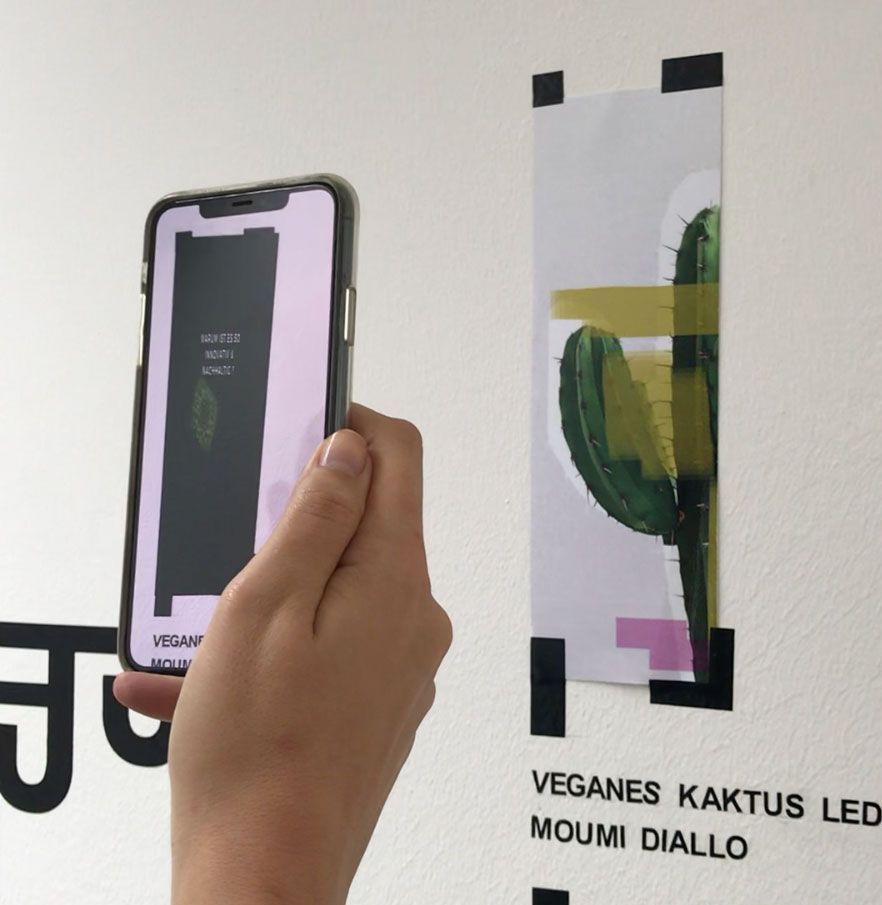Research Interests and Experience:
"Exploring the Impact of Immersive Technologies on Theoretical and Practical Design Practices"
by Zoya Laskowski
Introduction to Augmented Reality (AR)
How AR Blends Physical and Digital Worlds to Revolutionize Communication.
Impact of AR on Theoretical Design Practices
Redefining Design Principles for Augmented Reality: An Example of How AR Challenges Traditional Design and Reading Patterns in Multidimensional Spaces.
Impact of AR on Practical Design Practices
The following examples will demonstrate the impact on practical practices:
Enhancing Historical Exploration & Tourism with AR
AR City Walks Through Historic Düsseldorf – A Community-Driven Project with the European Union.
Revolutionizing Learning with Augmented Reality: A New Era of Interactive Education
Integrating Augmented Reality with Print Media for Enhanced Learning and Engagement
AR-based Advertising
Exploring Spatial Communication Design Through AR-Based Artworks and Student Projects.
The Role of Augmented Reality in Contemporary Society
Shaping Life, Learning, and Innovation.
Introduction to Augmented Reality (AR)
Introduction to Augmented Reality (AR)
The Digital Revolution
Shaping Society and Education
>> Daily Life and Beyond
The internet and digital devices have reshaped everyday life, business, politics, and education.
>> Ubiquity of Technology
Creative digital tools now influence nearly every aspect of society.
>> Adapting Education
Educational systems must prepare learners for new digital languages and innovative thinking.
>> Building Problem-Solving Skills
Advanced problem-solving is essential to thrive in the digital era.
What is Immersive Technology?
Immersive Technology extends reality or creates a new reality or experience by merging the physical world with digital or simulated reality.
What are different types of Immersive Technologies?
Virtual Reality (VR), 360-Degree Videos and Content, Haptic Technology, Augmented Reality (AR), Mixed Reality (MR), Projection-Based AR
What is Augmented Reality (AR) ?
Augmented Reality (AR) enhances real-world environments by overlaying digital content. The basic principle of Augmented Reality is to link digital content to an image. Therefore if anyone in any place holds a smartphone onto this image, the saved image will be recognized by an Augmented Reality browser, which forwards the user to the digital content that has been saved on this image.

Bildtitel
Untertitel hier einfügenButton
Bildtitel
Untertitel hier einfügenButton
Beyond the Surface: Bridging Worlds Through Immersive Design
Theoretical insights on why designers should embrace immersive technology by exploring counter-environments and multi-layered perspectives in both digital and primitive art.
>> Counter-Environments in Design: Fostering Interaction Between Old and New Spaces
Designers create counter-environments that merge traditional and modern elements, encouraging deeper engagement beyond surface-level interactions.
>> Lessons from Primitive Art:
Visualizing the Unseen for Deeper Understanding
Early artworks, such as depictions of hunters showing both surface and submerged scenes, mirror how immersive technology helps convey fuller environmental narratives today.
>> Immersive Technologies
and Perception: Revealing the Visible and the Invisible
Early artworks, such as depictions of hunters showing both surface and submerged scenes, mirror how immersive technology helps convey fuller environmental narratives today.
>> The Evolution of AR Applications: Dynamic Tools for Real-Time Adaptation
Advances like AI-driven World Skins enable augmented reality to adapt to changing environments dynamically, moving beyond static textures and pre-made assets.
Impact of AR on Theoretical Design Practices
Redefining Design Principles for Augmented Reality

Bildtitel
Untertitel hier einfügenButton
Bildtitel
Untertitel hier einfügenButton
Rethinking Reading:
An Example of How AR Redefines Linear Perception
>> The Influence of Linear Reading
Traditional printed text has conditioned humans to think rationally by following a structured, linear reading style: first A, then B, then C.
>> AR's Disruption of Linear Perception
Augmented Reality (AR) applications challenge the linear reading style, as the direction of reading is no longer fixed and depends on where the user’s gaze begins.
>> Factors Shaping Reading Direction in AR
Reading direction in AR varies based on the relevance or importance of displayed objects. Design elements like color, font size, alignment, and contrast play a critical role in guiding the reader’s attention.
>> Redefining Design Principles for Multidimensional Spaces
A key question arises: do traditional design principles hold the same function in extended multidimensional spatial environments as they do in 2D or 3D environments?
Do traditional design principles maintain the same function in extended multidimensional spatial environments?
Impact of AR on
Practical Design Practices
Shaping the Future of Design with Immersive Technology -
Exploring New Frontiers in Design and Communication
As Immersive Technology continues to evolve, designers have a crucial role in shaping how digital information is integrated into the physical world. This shift has the potential to transform design theory, redefine branding, and introduce new subcategories in graphic design. Furthermore, it offers exciting opportunities to enhance learning experiences in educational settings.
Awarded in the
European Union
As one of the
best practice studies
from 2014 to 2018
Augmented Reality-based application
Interdisciplinary European Research Project - Playback
Enhancing Historical Exploration & Tourism
with AR
Playback: Award-Winning Interdisciplinary European Research Project (2014-2018)
This AR-based application, "The People's Smart Sculpture (PS2), 2014-2018," offers an immersive journey through Düsseldorf’s past, featuring contributions from local residents and institutions. Designed for a broad audience, including tourists, newcomers, and students, it combines historical insights with location-based learning.

Design thinking & empirical research approaches
Untertitel hier einfügenButton
Examples from the image collection of the Düsseldorf City Archives.
Examples from the image collection of the
Düsseldorf City Archives.
Button
Digitizing Super 8 film material at the Film Museum
Digitizing Super 8
film material at the Film Museum.
Button
Bildtitel
Untertitel hier einfügenButton
Bildtitel
Untertitel hier einfügenButton
Theoretical foundation of the project
Untertitel hier einfügenButton
Bildtitel
Untertitel hier einfügenButton
Bildtitel
Untertitel hier einfügenButton
Slide title
Write your caption hereButton
Slide title
Write your caption hereButton
Slide title
Write your caption hereButton
Bildtitel
Untertitel hier einfügenButton
User Needs
Write your caption hereButton
Similar Projects at the Time
Similar Projects at the Time.
Button
Brainstorm Solutions Design Variations
Write your caption hereButton
Based on NFC (Near Field Communication)
Button
Video Projection AR Based
Brainstorm Solutions
Button
2 Models Inspired by a clock and reverse button
2 Models Inspired by a clock and reverse button
Button
Inspired by the clapperboard.
Brainstorm Solutions
Button
Final Solution
Augmented Reality based Application
Button
An Augmented Reality City Tour Combining Culture,
History, and Infrastructure - 2018
Exploring Düsseldorf's History Through Augmented Reality
>>Based on Design Thinking Methods with Integrated Empirical Research
This project combines design thinking and empirical research to create an immersive AR experience, grounded in user feedback and community involvement. It blends creativity with data-driven insights to enhance educational and cultural engagement in Düsseldorf's history.
>> Recognition &
Impact and Collaborative Effort
Awarded Best Practice Study (2014-2018) and featured in exhibitions such as the 2015 Night of Science in Düsseldorf.
Co-funded by the European Union in collaboration with the University of Applied Sciences Düsseldorf, the Film Museum Düsseldorf, and the City Archives Düsseldorf.
>> Target Audience, Adaptability
Designed for tourists, newcomers, residents, and students, the project offers a location-based learning experience that brings the city's past to life.
04
>> Theoretical foundation of the project
For this project, philosophical texts were used as background, including works by Henri Bergson, Aleida and Jan Assmann, and Marshall McLuhan.
The Future of Advertising: Augmented Reality Shaping New Experiences
Transforming Engagement through Immersive Experiences
How can brands create personalized campaigns with AR?
Augmented Reality (AR) can create eye-catching experiences in advertising by immersing customers in interactive, dynamic content that blends the physical and digital worlds, making products more engaging and memorable.
How does AR enhance consumer interaction?
AR ads merge digital content with the physical world, offering immersive and interactive experiences for consumers.
How does AR impact consumer engagement and loyalty?
By providing immersive experiences, AR boosts consumer engagement and fosters stronger brand loyalty.
Exploring Spatial Communication Design Through AR-Based Artworks - 2021
Virtual Exhibition Showcasing Student Projects Through AR Innovation
>> Innovative Use of AR in Fashion
The exhibition utilized Adobe Aero and Artivive to integrate 2D and 3D models and animations into the real world, showcasing the potential of augmented reality in fashion.
>> Student-Led Projects
Featuring 37 stations where students presented their projects to visitors, blending education with interactive, cutting-edge technology.
>> Exhibition Locations
The project was displayed at Düsseldorf’s prestigious Königsallee shopping street in September 2020 and as a permanent exhibition at the Fashion Design Institute in October 2020.
04
>> Guided Experience Design
Zoya Laskowski directed the creative vision and designed the navigational system, enhancing visitor engagement throughout the exhibition.
Revolutionizing Learning with Augmented Reality: A New Era of Interactive Education
AR-based textbooks transform complex subjects into dynamic, multidimensional learning experiences, enhancing comprehension, engagement, and retention.

Slide title
Write your caption hereButton
Slide title
Write your caption hereButton
Slide title
Write your caption hereButtonSlide title
Write your caption hereButton
Slide title
Write your caption hereButton
Transforming Education with
Augmented Reality
Enhancing learning through interactive, 3D experiences for better comprehension and retention
>> Enhanced Visualization of Complex Concepts
AR allows students to interact with 3D models, helping them visualize complex subjects like the human heart from various angles and in real-time, improving their understanding of intricate structures and functions.
>> Interactive Learning Experience
AR makes learning engaging by allowing students to interact with content, such as tapping on parts of a 3D heart model to explore its anatomy, providing a hands-on approach that enhances understanding through active participation.
>> Multidimensional Learning
AR provides students with the ability to explore topics from multiple perspectives, making it easier to understand multidimensional concepts, such as physiological processes, that are difficult to grasp through traditional methods.
04
>> Better Retention and Understanding
By offering immersive, interactive learning experiences, AR helps students retain information more effectively and fosters a deeper understanding of complex topics like human anatomy, molecular biology, and physics.
The Role of Augmented Reality in Contemporary Society
Applications in Life, Education, and Learning
AR Integration of Literature and Design - 2023
Virtual Exhibition Showcasing Student Projects Through AR Innovation
>> Cross-Department Collaboration:
The project brought together the Department of Business and Information Technology and the Department of English and Humanities, fostering collaboration between English Composition and design students.
>> Narrative Inspiration
English Composition students wrote narrative essays, which served as the foundation for design students to create digital and physical representations of universal themes.
>> Interactive Augmented Reality
Hidden URL links embedded within graphic elements on the windows of the Arts, English, and Humanities building allowed viewers to access AR content using the Artivive app.
>> Unified Student Vision
Throughout the semester, Professor Laskowski mentored students, ensuring the integration of individual projects into a unified, professional AR-based art installation that showcased the collective work of the class.





















